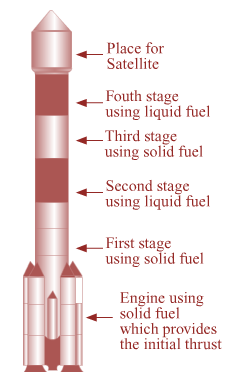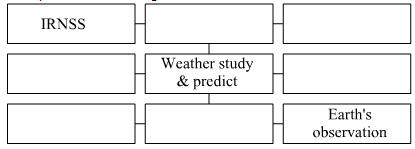Space Mission
Class 10-Science & Technology Part-1-Chapter-10- Maharashtra Board
Solution
Question 1:
Fill in the blanks and explain the statements with reasoning:
(1) If the height of the orbit of a satellite from the earth surface is increased, the tangential velocity of the satellite will ...... .
(2) The initial velocity (during launching) of the Managalyaan, must be greater than ..............of the earth.
(1) If the height of the orbit of a satellite from the earth surface is increased, the tangential velocity of the satellite will decrease. Explanation: The Gravitational force (F) exerted by the earth on the satellite will decrease if the height of the orbit of the satellite from the earth’s surface is increased. Hence the tangential velocity of the satellite will decrease. This can be easily inferred from the formula of critical or tangential velocity. \(v_c = \sqrt{\frac{GM}{Rh}}\) (2). The initial velocity (during launching) of the Managalyaan, must be greater than escape velocity of the earth. Explanation : Velocity of a satellite must be more than the escape velocity of the earth if a satellite is to travel beyond the gravitational pull of the earth
this shows that Vc decreases with increasing h
Question 2:
State with reasons whether the following sentences are true or false
1 If a spacecraft has to be sent away from the influence of earth’s gravitational field, its velocity must be less than the escape velocity.
False. Reason: This is because the minimum velocity with which the spacecraft must be projected so that it escapes the Earth's gravitational pull is known as escape velocity. So, the initial velocity of the spacecraft must be greater than or equal to escape velocity of Earth.
2. The escape velocity on the moon is less than that on the earth.
True: Reason: Escape velocity of an object from the earth is Escape velocity of an object from the moon is \(\frac{v_{esc}(M)}{v_{esc}(E)}=\sqrt{\frac{M_2}{M_1}×\frac{R_1}{R_2}}\) we know M1(Earth)/M2(Moon) = 81 and R1(Earth)/R2(moon)=3.7 ∴ \(\frac{v_{esc}(M)}{v_{esc}(E)}=\sqrt{\frac{3.7}{81}}<1\) ∴ \(v_{esc}(M) <v_{esc}(E)\) Thus the escape velocity on the Moon is less than that on the Earth. Hence, the statement is true.
\(v_{esc}(E) = \sqrt{\frac{2GM_1}{R_1}}\)
\(v_{esc}(M) = \sqrt{\frac{2GM_2}{R_2}}\)
3. A satellite needs a specific velocity to revolve in a specific orbit.
True: Reason: The specific velocity with which the satellite revolves around a planet is known as critical velocity. It is given as So, it can be observed that the critical velocity of a satellite changes depending on the height of the orbit from the surface of a planet. Thus, to revolve in a specific orbit, a satellite would require specific velocity. Hence, the statement is true.
\(v_c = \sqrt{\frac{GM}{R+h}}\)
4. If the height of the orbit of a satellite increases, its velocity must also increase.
False. Reason: The specific velocity with which the satellite revolves around a planet is known as critical velocity. It is given as So, we see that as the height (h) of the orbit of a satellite increases, its velocity decreases. Hence, the statement is false.
\(v_c = \sqrt{\frac{GM}{Rh}}\)
Question 3:
Answer the following questions:
a. What is meant by an artificial satellite? How are the satellites classified based on their functions?
A man made object revolving around the earth or any other planet in a fixed orbit is known as artificial satellites. Based on their functions, satellites are classified as following: Weather satellite : Collect the information regarding weather conditions of the weather. It records information like, temperature, wind direction, air pressure etc. and sent to the research center on the earth. Based on this information study and prediction of weather is made. Navigational satellite : Fix the location of any place on the Earth’s surface in terms of its very precise latitude and longitude. These satellites assist the user with current live maps as well as real time traffic conditions, also assist the surface, water and air transportation and coordinate their busy schedule. Broadcasting satellites : Broadcasting satellites are used to transmit various radio and television programmes and even live programmes from any place on the earth to any other place. Earth observation satellites : Use of these satellites are to observe and provide the real time information about the earth. These satellites also help us to collect the information about the resources, their management, and continuous observation about a natural of natural calamities like flood and earthquake and the changes within it. Communication satellites : These satellites establish communication between different location in the world through use of specific waves. In order to establish communication between different places on the earth through mobile phones or computer internet communication satellites are used. Military satellites : These satellites are used to collect information for security aspects. Every sovereign country needs to keep the real time information about the borders. Satellites help to monitor all movements of neighbouring countries or enemy countries. Military satellites also help to guide the missiles effectively. Apart from these various satellites, certain satellites for specific works or purposes are also sent in the space. E.g. India has sent and using satellite EDUSAT for educational purpose: CARTOSAT for surveys and map making.
b. What is meant by the orbit of a satellite? On what basis and how are the orbits of artificial satellites classified?
Orbit of a satellite Is its path around the earth. Orbits of artificial satellites can be classified on various basis.
(1) On the basis of the angle of the orbital plane : Orbital plane of a satellite can be the equatorial plane of the earth or it can be at an angle to it
(2) On the basis of the nature of the orbit : Orbital plane can be circular or elliptical in shape.
(3) On the basis of the height of the satellite : Orbit of a satellite can be HEO, MEO or LEO
c. Why are geostationary satellites not useful for studies of polar regions?
Thus, these are not useful for studies of polar regions.
d. What is meant by satellite launch vehicles? Explain a satellite launch vehicle developed by ISRO with the help of a schematic diagram.
A rocket used to carry an artificial satellite to a desired height above the earth's surface and then project it with a proper velocity so that the satellite orbits the earth in the desired orbit is called a launch vehicle. The structure of polar satellite launch vehicle (PSLV) developed by ISRO is shown above. It is a vehicle with 4 stages using solid and liquid fuels. The weight of the vehicle decreases after each stage because of consumption of fuel at that stage and detachment of that stage (i.e. the empty tank) from its body. Thus, the vehicle moves with higher speed after every stage.

e. Why it is beneficial to use satellite launch vehicles made of more than one stage?
The major portion of weight in satellite launch vehicles is contributed by fuel. Thus, vehicles have to carry a large weight of fuel during their course of journey. Earlier Satellite Launch Vehicles (SLV) used to be of a single stage vehicles. Such SLVs used to be very heavy as well as expensive in terms of its fuel consumption. To overcome this problem of launch vehicles carrying heavy load during its entire journey, it is provided with more than one stage. In multistage the weight of the vehicle can be reduced step by step, after its launching. Thus, it saves fuel consumption. Hence, it is beneficial to use a multistage satellite launch vehicle
Question 4:
Complete the following table.

Question 5:
Solve the following problems.
1. If mass of a planet is eight times the mass of the earth and its radius is twice the radius of the earth, what will be the escape velocity for that planet?
Given : Mass of the planet, Mp = 8×Mass of the Earth (Me)=8×6×1024kg G= Gravitational constant 6.67x10-11 N-m2/kg2 (Ref-Text Book data) Escape velocity for that planet is \(v_{esc} = \sqrt{\frac{2GM}{R}}\) \(v_{esc} = \sqrt{\frac{2×6.67×10^{-11}×8×6×10^{24}}{2×6.4×10^6}}m/s\) \(v_{esc} = \sqrt{\frac{6.67×3×10^8}{4}}m/s\) \(v_{esc} = \sqrt{\frac{20.01×10^8}{4}} m/s\) \(v_{esc} = 2.237×10^4 m/s\) \(v_{esc} = 22.37km/s\) Answer is 22.4 km/s
Radius of the planet, Rp = 2×Radius of the Earth (Re)= 2×6.4x106 m
2. How much time a satellite in an orbit at height 35780 km above earth's surface would take, if the mass of the earth would have been four times its original mass?
Given: ∴ M’= 4×6×1024kg Radius of the Earth (R)= 6.4x106 m G= Gravitational constant 6.67x10-11 N-m2/kg2 (Ref-Text Book data) Time taken by the satellite to revolved around the Earth's orbit is given as \(v_c = \sqrt{\frac{GM'}{R+h}}\) ∴\(T = \frac{2π(R+h)}{\sqrt{\frac{GM'}{R+h}}}\) ∴\(T = \frac{2π(R+h)^{3/2}}{\sqrt{GM'}}\) \(T = \frac{2π(6.4×10^6+35.78× 10^6 )^{3/2}}{\sqrt{6.67×10^{-11}×4× 6×10^{24}}}s\) \(T = 4.303×10^4 s Approx\) \(T = 4.303×10^4 /3600 h Approx\) \(T = 11.95 h Approx\) T= 11 hours 57 minutes apparox
Height of the satellite, h = 35780 km = 35.78×106 m
Let the original mass of Earth be M. Then its new mass M’ will be 4M.
T=2π(R+h)/vc
Now, vc is given as
3. If the height of a satellite completing one revolution around the earth in T seconds is h1meter, then what would be the height of a satellite taking \(2\sqrt{2}T\) seconds for one revolution?
Time period of the satellite is given as When the height of the satellite is h1, it takes T time to revolve around the Earth. Thus, at height h1 When the satellite takes \(2\sqrt{2}T\) time to revolve around the Earth, let it be at height h2. Thus, Dividing (ii) by (i), we get \(2^{3/2} =\frac{(R+h_2)^{3/2}}{(R+h_1)^{3/2}}\) \(2 =\frac{(R+h_2)}{(R+h_1)}\) 2R+2h1 = R+h2 ∴ h2=R+2h1
\(T = \frac{2π(R+h)^{3/2}}{\sqrt{GM}}\)
∴ \(T = \frac{2π(R+h_1)^{3/2}}{\sqrt{GM}}\) .... (i)
\(2\sqrt{2}T =\frac{2π(R+h_2)^{3/2}}{\sqrt{GM}}\) .....(ii)
\(2\sqrt{2} =\frac{(R+h_2)^{3/2}}{(R+h_1)^{3/2}}\)
Useful links :
| Main Page : - Maharashtra Board Class 10 Science & Technology Part-1,Part-2 - All chapters notes, solutions, videos, test, pdf.
Books : MSBSHSE -Class 10th Science Text Books – Chapter wise PDF for download Videos : MSBSHSE Class 10th Science & Technology-2-Videos - Chapter wise Videos Previous Chapter : Chapter-9-Carbon compounds - Online Solution |
Can i get shot notes of space mission.
notes uploaded- Click here